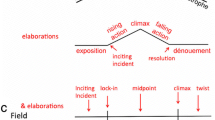Abstract
Given a corpus of western classic plays, how to efficiently mine their potential composing patterns is an open issue in computational linguistics. Several methods have been proposed to extract and analyze their character networks, however at least two problems remain unsolved: (1) the modeling is time-consuming and imprecise since it is difficult to identify “who talks to whom”, and (2) the analysis fails to reveal the evolving path from micro features to macro emergences, where the key attribute of plays, i.e. diversified protagonist characteristics, shaped. In this paper, by making good use of the play narratage (off screen voice) and the network motif theory, we propose a novel mining framework, called wMotif. The framework consists of five algorithms, preprocessing, stage iteration, character identification, character correlating and weighted motif mining. Considering top 9 referred network indices as contenders, we take 65 real-world classic plays as the dataset and evaluate wMotif’s performance upon a playwright predicting problem. Comparisons show that wMotif is superior in precision, complexity and visualization. Through wMotif we find that, (1) complete triads with pure strong (motif #1306) or weak (motif #1360) edges are the top two significant patterns for playwright predicting, and (2) given a strong speaker-to-listener correlation, whether in most cases both ends loosely connect to a shared character (motif #512) can indicate a work’s genre.












Similar content being viewed by others
References
Alberich R, Miro-Julia J, Rossello F (2002) Marvel Universe looks almost like a real social network. arXiv preprint. https://arxiv.org/abs/cond-mat/0202174. Accessed 12 June 2015
Ardanuy MC, Sporleder C (2014) Structure-based clustering of novels. Proc. of CLfL@EACL 2014, Association for Computational Linguistics 31–39
Bastian M, Heymann S, Jacomy M (2009) Gephi: an open source software for exploring and manipulating networks. Proc. of ICWSM 2009, Association for the Advancement of Artificial Intelligence 361–362
Breiman L (2001) Random forests. Mach Learn 45(1):5–32
Buitinck L, Louppe G, Blondel M, et al (2013) API design for machine learning software: experiences from the scikit-learn project. arXiv preprint. https://arxiv.org/abs/1309.0238. Accessed 12 June 2015
Choi YM, Kim HJ (2007) A directed network of Greek and roman mythology. Physica A: Statistical Mechanics & Its Applications 382(2):665–671
Condello M, Harrison R, Isasi J et al (2015) A methodology for character networks at the macro analytical level. Digital Humanity Forum 2014:1–4 http://idrh.ku.edu/dhforum2014. Accessed 12 June 2017
Elson D K, Dames N, Mckeown KR (2010) Extracting social networks from literary fiction. Proc. of ACL 2010, Association for Computational Linguistics 138–147
Fawcett T (2006) An introduction to ROC analysis. Pattern Recogn Lett 27(8):861–874
Ferri C, Hernández-Orallo J, Modroiu R (2009) An experimental comparison of performance measures for classification. Pattern Recogn Lett 30(1):27–38
Gil S, Kuenzel L, Caroline S (2011) Extraction and analysis of character interaction networks from plays and movies, Stanford CS 224W Final Project Report. Accessed June 2015
Holanda AJ, Matias M, Ferreira S, et al (2017) Character Networks and Book Genre Classification. arXiv preprint arXiv:1704.08197
Hylton J (2011) The complete works of Shakespeare. Massachusetts Institute of Technology. http://shakespeare.mit.edu/. Accessed 12 June 2015
Kwon HC, Shim KH (2017) An improved method of character network analysis for literary criticism: a case study of < hamlet>. International Journal of Contents 13(3):43–48
Li JD (2017) The classic play parsing project. GitHub: https://github.com/smellydog521/classicPlayParsing/
Li J, Yang D, Ji C (2017) Mine weighted network motifs via Bayes' theorem. Proc. of ICSAI2017, IEEE 448–452
Mac P, Kenna R (2014) A quantitative approach to comparative mythology. Cosmos 1–22
Milo R, Shen-Orr S, Itzkovitz S et al (2002) Network motifs: simple building blocks of complex networks. Science 298:824–827
Moretti F (2011) Network theory, plot analysis. New Left Rev 68:80–104
Moretti F (2013) 'Operationalizing' or, the function of measurement in literary theory. New Left Rev 84:103–119
Moretti F (2017) Patterns and interpretation. Literary Lab in Stanford University 1–10
Müngen AA, Kaya M (2017) Influence analysis of posts in social networks by using quad-motifs. Proc. of IDAP 2017, IEEE 1–5
Paranjape A, Benson AR, Leskovec J (2017) Motifs in temporal networks. Proc. of WSDM 2017, ACM 601–610
Park GM, Kim SH, Cho HG (2013) Structural analysis on social network constructed from characters in literature texts. Journal of Computers 8(9):2442–2447
Pierson E (2014) Parsing is such sweet sorrow. Prezi.com. https://prezi.com/gw5m3fbs82gv/parsing-is-such-sweet-sorrow/. Accessed 12 June 2015
Prado SD, Dahmen SR (2016) Temporal network analysis of literary texts. Advs Complex Syst 19(03):1–17
Project Gutenberg Literary Archive Foundation (2015) Play scripts of Shaw and Ibsen. http://www.gutenberg.org. Accessed 12 June 2015
Rydberg-Cox J (2011) Social networks and the language of Greek tragedy. Journal of the Chicago Colloquium on Digital Humanities and Computer Science 1(3):1–11
Stiller J, Hudson M (2005) Weak links and scene cliques within the small world of Shakespeare. J Evol Psychol 3(1):57–73
Tran QD, Hwang D, Lee OJ et al (2017) Exploiting character networks for movie summarization. Multimedia Tools and Applications 76(8):10357–10369
Wernicke S, Rasche F (2006) FANMOD: a tool for fast network motif detection. Bioinformatics 22(9):1152–1153
Woloch A (2009) The one vs. the many: minor characters and the space of the protagonist in the novel. Princeton University, New Jersey, USA
Yang D, Guo J, Wang ZJ et al (2018) FastPM: an approach to pattern matching via distributed stream processing. Inf Sci 453:263–280
Acknowledgements
This work is supported by National Nature Science Foundation of China under grant No.61702320, Shanghai Municipal Education Commission Funds of Teaching Science Research Program No.C17014 and Shanghai Municipal Education Commission Funds of Young Teacher Training Program No.ZZSDJ17021. The authors also thank all anonymous reviewers who greatly help improve the quality of this paper.
Author information
Authors and Affiliations
Corresponding author
Additional information
Publisher’s Note
Springer Nature remains neutral with regard to jurisdictional claims in published maps and institutional affiliations.
Rights and permissions
About this article
Cite this article
Li, J., Yang, D. & Lv, P. Visualize classic play’s composing patterns: a weighted motif mining framework. Multimed Tools Appl 78, 5989–6012 (2019). https://doi.org/10.1007/s11042-018-6405-7
Received:
Revised:
Accepted:
Published:
Issue Date:
DOI: https://doi.org/10.1007/s11042-018-6405-7




